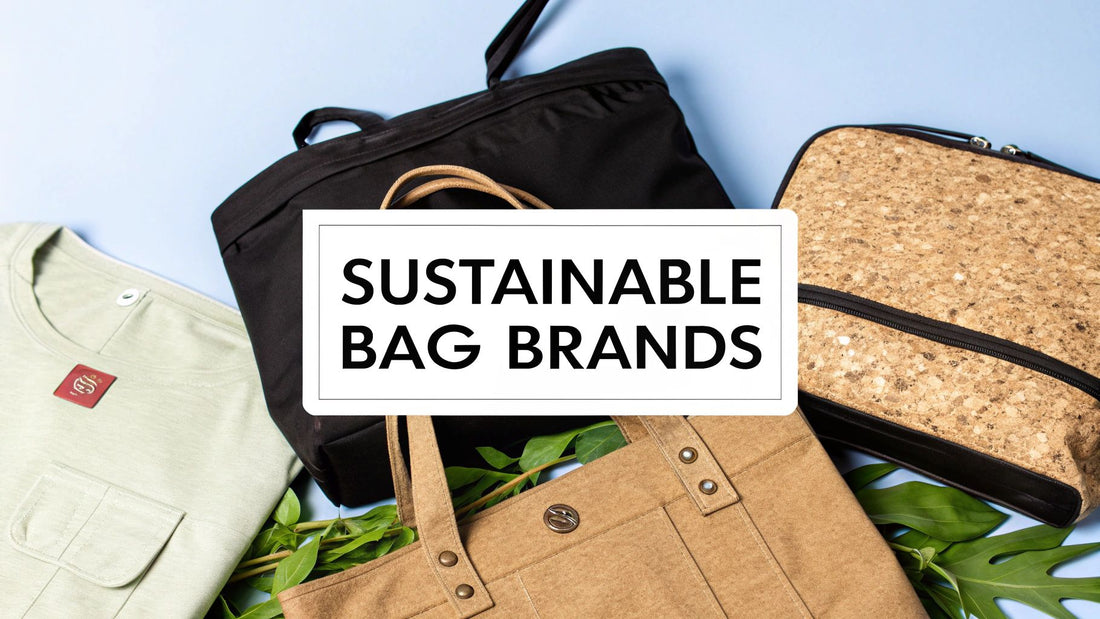
Your Guide to Sustainable Bag Brands
Share
Sustainable bag brands are about so much more than just the latest trends. They represent a deliberate move away from the fast fashion cycle, prioritizing ethical production, eco-friendly materials, and creating bags that are built to last. It’s a conscious choice to back companies that value people and the planet just as much as they value profit.
This isn't just a fleeting moment; it's a fundamental shift in how we think about the accessories we carry every day.
Beyond the Buzzword: What Sustainability Really Means
The word "sustainable" gets thrown around a lot in marketing, but what does it actually mean for a bag brand? It’s not about checking a single box, like using recycled plastic. Real sustainability is a holistic approach—it looks at the entire life of a bag, from the moment its materials are sourced to the day it's eventually retired.
This is often called the triple bottom line, a framework where a company’s success isn’t just measured by its financial performance, but also by its social and environmental impact.
A truly sustainable brand has solid answers to the tough questions. Where did the raw materials come from? Were the artisans who stitched this bag together treated with respect and paid a fair wage? And what happens to the bag when it reaches the end of its life?
The Three Pillars of Sustainable Fashion
To make it simple, think of sustainability as a three-legged stool. If one leg is shaky, the whole thing topples over. For a bag brand to be truly sustainable, it needs to be strong in all three areas:
- Environmental Impact: This is all about being kind to our planet. It means using renewable or recycled materials, cutting down on water and energy use during production, and designing durable products that you won't need to replace every season.
- Social Responsibility: This is the human side of the equation. It’s a promise that everyone in the supply chain—from the farmer growing the cotton to the person sewing the final seams—works in safe conditions and earns a living wage.
- Economic Viability: A brand can’t do good if it goes out of business. This pillar ensures the company has a solid business model that can support its ethical mission for the long haul, without ever cutting corners on quality or fairness.
This shift in thinking is already making waves. The global market for sustainable bags was valued at around USD 3.4 billion and is expected to hit USD 9.5 billion in the next decade, growing at a healthy clip of 12.1% annually. That’s not just a statistic; it’s proof that people are demanding better products from better companies. You can dive deeper into the undeniable importance of eco-friendly products to see how this movement is shaping our future.
To help you quickly spot a genuinely sustainable brand, we’ve broken down these core principles into a simple table.
Key Pillars of a Sustainable Bag Brand
Here’s a quick summary of the core principles that define an authentic sustainable bag brand, helping you grasp the key concepts at a glance.
| Pillar | What It Means for You | Example in Practice |
|---|---|---|
| Eco-Friendly Materials | The bag is made from materials that are either renewable, recycled, or biodegradable, reducing its environmental footprint. | Using GOTS-certified organic cotton, recycled polyester (rPET), or innovative plant-based leathers. |
| Ethical Production | The people who made your bag were treated fairly, worked in safe conditions, and were paid a living wage. | A brand holding Fair Trade or SA8000 certifications and being transparent about its factory partners. |
| Durability & Longevity | The bag is designed and built to last for years, not just a single season, which reduces waste and consumption. | Using high-quality stitching, durable hardware, and offering repair programs for their products. |
| Transparency | The brand openly shares information about its supply chain, materials, and production processes. | Publishing an annual impact report or providing detailed information on their website about where and how their bags are made. |
These pillars aren't just marketing points; they are the foundation of a brand you can truly feel good about supporting.
A sustainable bag is more than just an accessory. It's a statement about your values and a vote for a fashion industry that is kinder to the earth and its inhabitants. It proves that style and substance can, and should, coexist.
Exploring Eco-Friendly Bag Materials
The true heart of any sustainable bag is the material it’s made from. You can think of it like cooking a great meal—the quality of your ingredients ultimately determines the final dish. For any brand serious about sustainability, choosing the right fabric is the single most important step in creating a bag that’s both beautiful and kind to the planet.
These materials are the building blocks of a better, more conscious fashion industry.
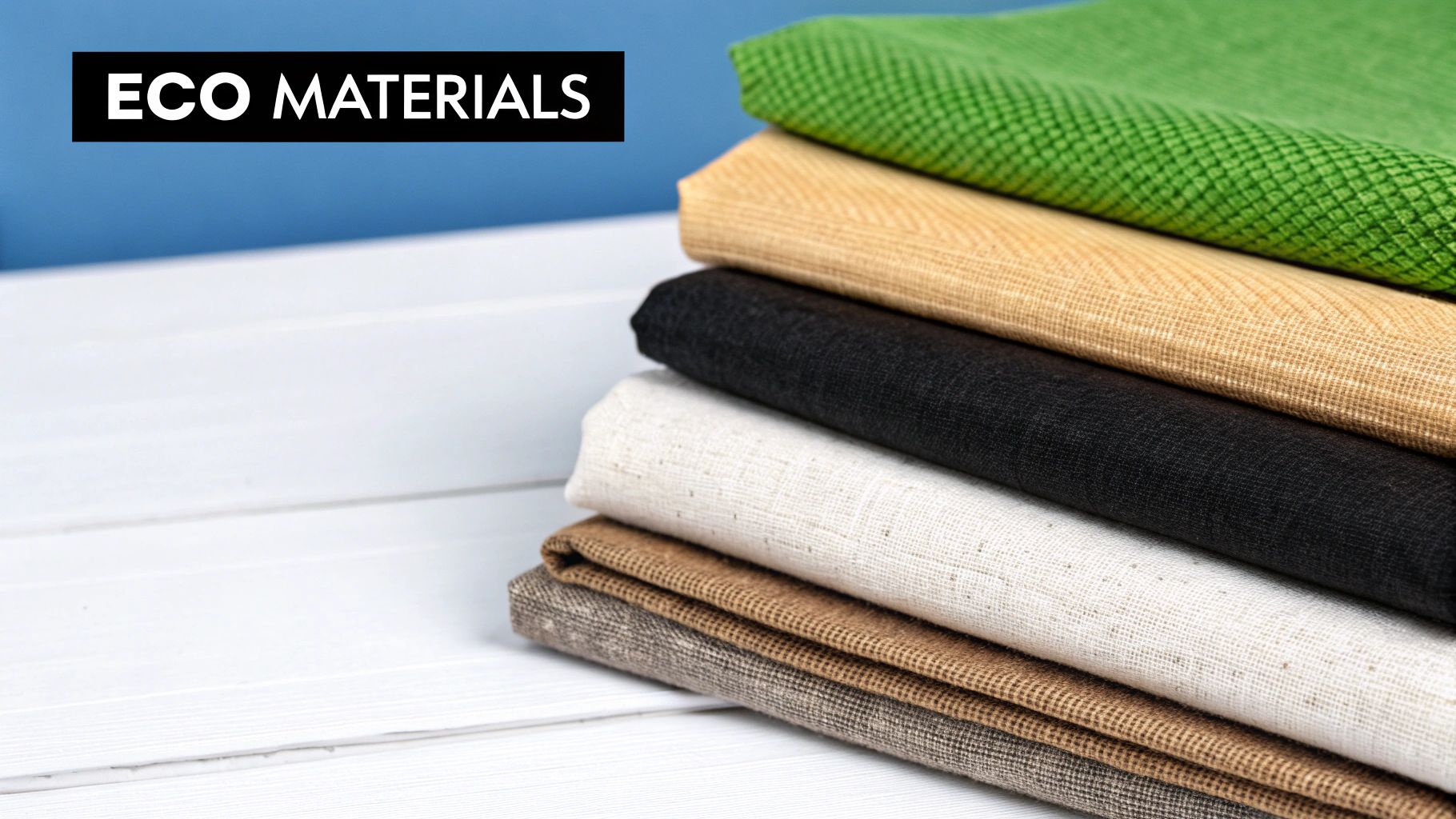
The world of eco-friendly fabrics is way more exciting than you might think, moving far beyond the usual suspects. From tough, plant-based textiles to brilliant materials born from literal trash, the options are more creative than ever. Let's get into some of the key players shaping the future of sustainable accessories.
Plant-Based Powerhouses
It turns out nature has always provided the best resources, and smart brands are circling back to these roots. Plant-based materials are celebrated for being renewable, biodegradable, and often requiring far fewer resources to produce than their synthetic cousins.
- Organic Cotton: Conventional cotton is a notoriously thirsty crop that relies heavily on pesticides. Organic cotton, on the other hand, is grown without nasty chemicals, which protects soil health, conserves water, and creates a safer environment for farmers.
- Hemp: This is a true environmental champion. It's a fast-growing plant that needs very little water, zero pesticides, and actually helps regenerate the soil it grows in. The fabric it produces is incredibly durable and just gets softer with age.
- Cork: Harvested from the bark of cork oak trees without ever harming them, this material is a fantastic sustainable choice. The bark regenerates every nine years, making it a completely renewable resource. Cork is also lightweight, water-resistant, and has a unique, earthy vibe.
These materials prove that strength and style don't have to come at the environment's expense.
The Rise of Recycled Fabrics
One of the coolest things happening in sustainable fashion is giving waste a new life. This approach tackles the massive problem of plastic pollution and textile waste head-on, turning discarded junk into high-quality, durable fabrics for new products.
Instead of creating materials from scratch—a process that drains resources—recycling diverts waste that would otherwise clog up landfills and oceans. It uses way less energy and water than producing virgin fibers, making it a huge win for everyone.
By choosing a bag made from recycled materials, you are directly participating in a circular economy—a system where waste is not an endpoint, but a beginning.
Two standout materials are really changing the game here:
- Recycled PET (rPET): This is the fabric you get when you clean, melt, and spin plastic water bottles into polyester yarn. It’s a genius way to give single-use plastics a second chance as a durable, versatile textile for backpacks, totes, and all kinds of bags.
- ECONYL®: This stuff is brilliant. It's regenerated nylon sourced from waste like old fishing nets, fabric scraps, and industrial plastic. It helps clean up our oceans while creating a premium fabric that is identical in quality to brand-new nylon.
Next-Generation Vegan Leathers
The demand for cruelty-free alternatives has sparked incredible innovation in vegan leathers that are also gentle on the planet. Forget the sweaty, PVC-based "pleathers" of the past; these are sophisticated materials made from surprising and sustainable sources. This is a booming market—the luxury vegan handbag space alone was valued at USD 1.67 billion and is projected to more than double.
Brands are now crafting beautiful bags from all sorts of plant-based materials:
- Piñatex®: An innovative natural textile made from waste pineapple leaf fibers.
- Mushroom Leather (Mycelium): Grown from the root structure of mushrooms, this material has a look and feel that's remarkably similar to animal leather.
- Apple Leather: Made from the pulp and peel waste from the apple juice industry.
These materials show a powerful shift toward resourcefulness. A great example of this is how brands are incorporating high-quality, eco-conscious vegan leather into modern designs, like this eco-friendly vegan leather weekender bag. By choosing materials thoughtfully, sustainable bag brands offer products that align with both your style and your values.
Understanding Sustainability Certifications
Ever feel like you need a secret decoder ring to understand all the eco-labels on product tags? You see a flurry of logos and acronyms, but what do they really mean? Think of these certifications as a stamp of approval from a trusted expert. They cut through all the marketing fluff to prove a brand's sustainable claims are the real deal.
These labels aren’t just for decoration; they represent a serious commitment to meeting tough, third-party standards. When you spot a recognized certification on a bag, it means an independent group has gone through the brand’s supply chain, materials, and labor practices with a fine-tooth comb. They've confirmed everything meets a high bar for environmental and social responsibility. This is your best defense against greenwashing and your surest way to support genuinely sustainable bag brands.
Material and Product Focused Certifications
Some of the most common certifications you'll see are all about the materials themselves. They give you peace of mind that the fabric was produced in a way that minimizes harm to the planet and, often, to the people who made it. These labels are a clear signal about the eco-friendliness of a bag's core components.
A few key ones to keep an eye out for:
- Global Organic Textile Standard (GOTS): This is pretty much the gold standard for organic fibers. If a bag is GOTS-certified, it guarantees the cotton (or another fiber) was grown without nasty pesticides. It also ensures the whole production process, from farm to factory, was environmentally and socially responsible.
- Global Recycled Standard (GRS): This is your proof that a product truly contains recycled material. It verifies the exact percentage and tracks it from the recycling bin to the final product, all while making sure the processing is done responsibly.
- Forest Stewardship Council (FSC): You might associate this with paper, but it’s also vital for materials like cork or even some plant-based fabrics. An FSC logo means the material came from a responsibly managed forest, one that prevents deforestation and protects wildlife.
Company-Wide Ethical Certifications
Beyond the raw materials, other certifications take a much bigger-picture view, looking at how a company operates as a whole. These labels tell you that the brand itself is dedicated to being a force for good—thinking about its impact on its workers, its community, and the environment. It’s a holistic approach that helps you spot the truly ethical players.
Choosing a brand with these certifications means you're supporting a business that has voluntarily opened its doors to outside scrutiny to prove its commitment to doing things the right way.
Here are two major certifications that assess a brand’s entire operation:
- B Corporation (B Corp): This is a heavy-hitter. It’s a comprehensive certification that measures a company's entire social and environmental performance. To become a B Corp, a brand must hit incredibly high standards of transparency and accountability, proving it balances profit with purpose. It’s a sign that the business is legally wired to consider its impact on everyone.
- Fair Trade Certified: This label is all about the people behind the product. It ensures workers in the supply chain get fair wages, have safe working conditions, and are empowered through community development funds. When you see this on a bag, you know your purchase is directly supporting the artisans and farmers who made it possible.
To make sense of these labels at a glance, we've put together a quick reference table.
Common Sustainability Certifications Explained
| Certification Logo/Name | What It Guarantees | Applies To |
|---|---|---|
| GOTS | That textiles are made from at least 70% certified organic natural fibers. | Products (e.g., cotton bags, clothing) |
| GRS | Verifies at least 20% recycled content and ensures responsible social and environmental practices in production. | Products (e.g., bags made from recycled polyester) |
| FSC | That materials come from responsibly managed forests that provide environmental, social, and economic benefits. | Products (e.g., cork accessories, paper packaging) |
| B Corp | That a company meets high standards of social and environmental performance, accountability, and transparency. | Entire Company/Brand |
| Fair Trade | That products were made under fair labor conditions, ensuring fair wages and safe environments for workers. | Products & Ingredients (e.g., cotton, coffee) |
These certifications are more than just symbols; they are stories of responsibility and care woven into the products you buy.
This infographic breaks down how a few leading sustainable bag brands stack up against each other, showing how data can illuminate their commitments.
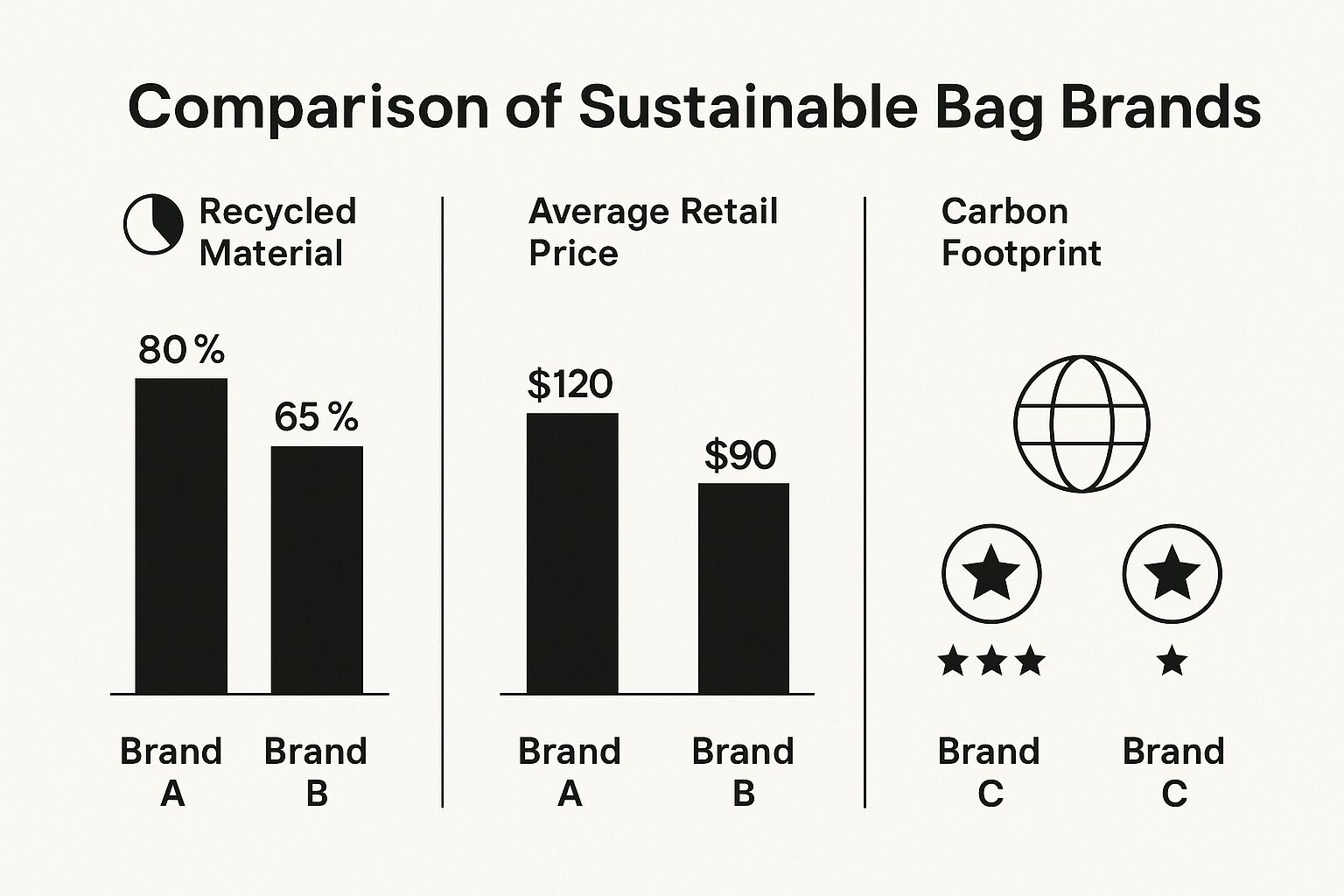
As you can see, different brands might shine in different areas. One might lead with a higher percentage of recycled materials, while another might have a smaller carbon footprint. Understanding these labels empowers you to make a choice that truly reflects what matters most to you.
How to Vet Sustainable Bag Brands Yourself
Alright, so you’ve got the certifications down. Now it's time to put on your detective hat.
Moving beyond the official labels and shiny marketing claims means doing a little digging yourself. It's about learning to ask the right questions and knowing what a solid answer looks like. This simple shift turns you from just another buyer into someone who actively supports real, positive change in the fashion world.
Think of it like being a food critic. A great critic doesn't just taste the final dish on the plate. They're curious about where the ingredients came from, the chef's techniques, and even the kitchen's standards. Vetting a sustainable bag brand works on the same principle—you have to look at the entire story, not just the pretty product at the end.
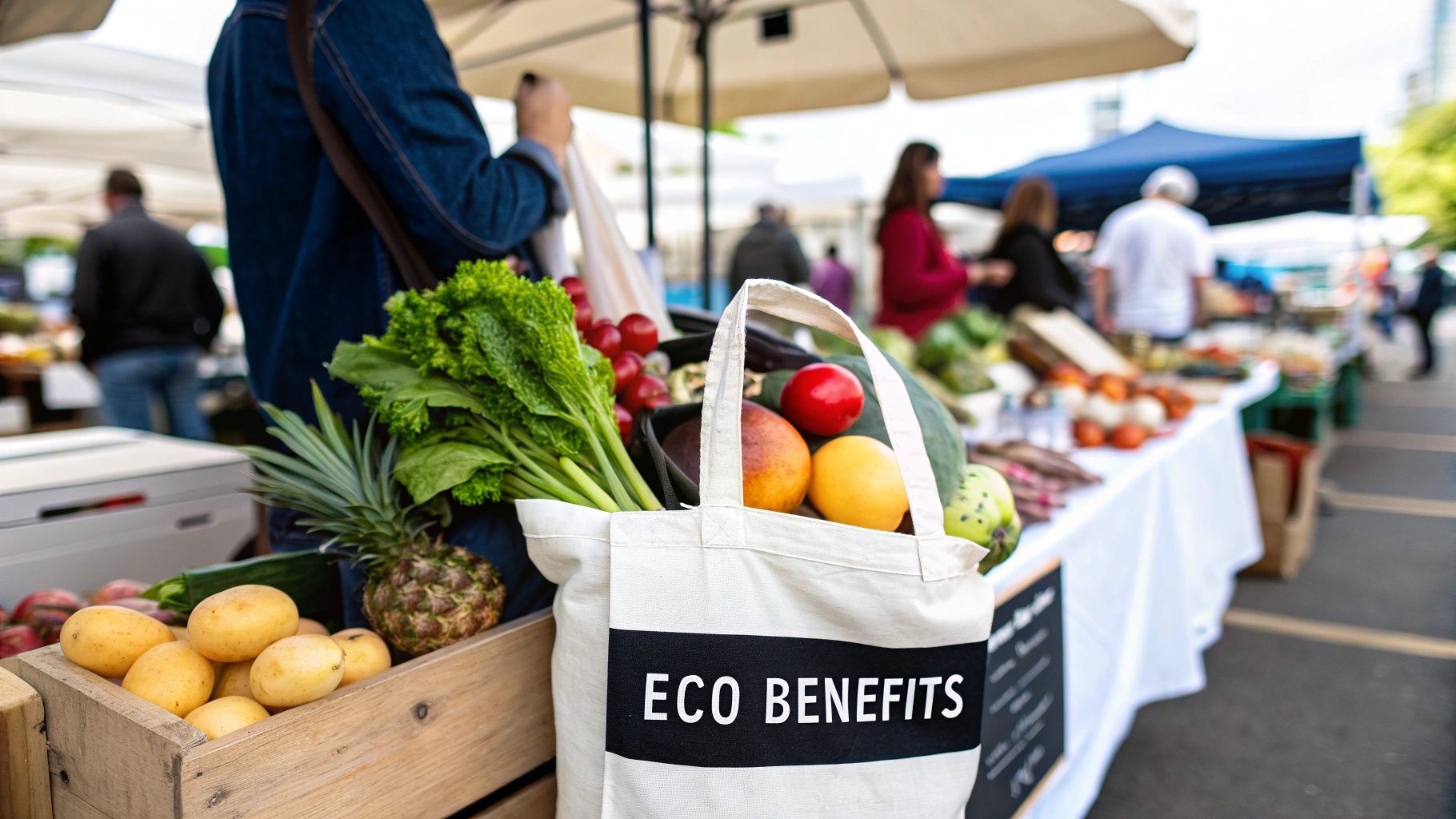
Unpacking Brand Transparency
The first thing to hunt for? Transparency. It's the biggest tell. A brand that's genuinely sustainable isn't afraid to pull back the curtain and show you exactly how its bags are made. If their story is vague or they're silent about their process, that's usually a red flag.
Real transparency isn't about fluffy words; it’s about sharing specific, concrete details. You should be able to find this info on their website without needing a magnifying glass. Vague claims like "ethically made" just don't cut it anymore. We need the receipts.
Here's what to look for:
- Supply Chain Details: Do they tell you where their materials are sourced? A truly transparent brand might name the specific region or even the farm that grew its organic cotton.
- Factory Information: Are they open about their manufacturing partners? The best brands will often share the names and locations of their factories, maybe even details about audits and the conditions for their workers.
- Annual Impact Reports: Many of the most committed brands publish yearly reports. These documents break down their environmental footprint, labor stats, and the progress they're making toward their goals.
A brand truly committed to sustainability sees transparency not as a chore, but as a core part of who they are. They're proud of how they do things and are eager to share that story with customers who care.
Evaluating the Manufacturing Process
Next, let's zoom in on how the bag is actually put together. This is where a brand’s eco-friendly promises move from words on a screen to real-world action. A forward-thinking brand is always looking for ways to lighten its footprint at every single step, from dyeing the fabric to shipping the final product to your door.
You can usually find these details on a brand’s "About Us" or "Sustainability" page.
Look for these key signs of a responsible process:
- Water Conservation: Textile manufacturing, especially the dyeing process, is incredibly thirsty. Look for brands that use water-saving techniques or even closed-loop systems that recycle water.
- Reduced Chemical Use: Are they using non-toxic, low-impact dyes? A certification like OEKO-TEX Standard 100 is a great sign, as it confirms a product is free from a long list of harmful substances.
- Carbon Neutrality: A growing number of brands are actually measuring their carbon footprint and taking real steps to offset it, either through renewable energy or carbon credit programs. It shows a deep commitment to the climate.
The Commitment to Circularity and Longevity
Finally, a top-tier sustainable brand thinks about the bag’s entire life—especially what happens after you’re done with it. This is the heart of the circular economy, a system designed to eliminate waste by keeping products and materials in use for as long as possible.
This mindset is the complete opposite of the "take-make-waste" model that defines fast fashion. Instead of churning out disposable accessories, these brands design for durability and have a plan for a product's end-of-life. If you want to dive deeper into this way of thinking, check out our guide on mindful fashion and how to express yourself while caring for the planet.
Keep an eye out for these circular initiatives:
- Repair Programs: Will the brand fix your bag if a strap breaks or a zipper fails? This shows they believe in their craftsmanship and want you to use their product for years.
- Take-Back Options: Can you send the bag back when it's truly at the end of its road? This demonstrates that the brand takes full responsibility for what it creates.
- Timeless Design: Is the style a classic that will still look good long after today's trends have faded? Longevity is sustainability. The most eco-friendly bag is the one you love and use for years and years.
By asking these questions, you can cut through the greenwashing and find the brands that are genuinely walking the walk.
A Few Sustainable Bag Brands We Admire
Theory is great, but seeing these principles in action is what really sparks inspiration. Now that you know what to look for—from conscious materials to trustworthy certifications—let's check out a few sustainable bag brands that are absolutely leading the charge.
These companies prove you never have to pick between killer style, everyday function, and your own ethics. This isn’t a complete list, but it’s a snapshot of the incredible creativity and commitment bubbling up in the sustainable fashion world. Each brand has its own story, its own vibe, and its own way of making a positive dent in the universe.
Patagonia: Built to Endure
Patagonia is often held up as one of the original pioneers of corporate responsibility, and their bags are a perfect reflection of that legacy. They aren’t just making products; they’re building gear designed to survive the harshest conditions and last for decades—a core tenet of sustainability.
Their commitment is legendary, from using a huge percentage of recycled materials to their Ironclad Guarantee, which promises to repair, replace, or refund anything that doesn’t hold up. This fierce focus on longevity is a powerful middle finger to the throwaway culture of fast fashion.
- Signature Materials: Durable recycled polyester and recycled nylon.
- Price Range: $30 - $200
- Styles: Rugged backpacks, functional duffels, and everyday totes.
Matt & Nat: Pioneering Vegan Luxury
For anyone hunting for a chic, cruelty-free option, Matt & Nat has been a go-to for years. The brand's name itself stands for MAT(T)ERIAL + NATURE, and they’ve built their entire identity around exploring the magic between the two. They've been committed to skipping leather and any other animal-based materials since day one.
They’re famous for using innovative recycled materials, especially for their signature linings. The inside of every single bag is made from 100% recycled plastic bottles, a tangible example of turning trash into something beautiful and useful.
- Signature Materials: High-quality vegan leathers like PU (polyurethane) and PVC (polyvinylchloride), with linings made from recycled bottles.
- Price Range: $100 - $250
- Styles: Sophisticated handbags, minimalist backpacks, and professional briefcases.
Choosing a sustainable bag brand means investing in a story of respect—for the planet, for the people who made it, and for the future. It's about carrying your values with you, every single day.
Cuyana: Fewer, Better Things
Cuyana’s whole philosophy is elegantly simple: "fewer, better things." This mantra is a direct challenge to the fast-fashion model, encouraging us to invest in timeless, high-quality pieces we’ll love and use for years. Their focus is on intentional design and exceptional craftsmanship.
The brand champions sustainability by creating classic, versatile bags from premium materials sourced from around the globe. They're also deeply committed to transparency, giving you clear info about their tanneries and factories, all of which stick to strict environmental and social standards.
- Signature Materials: Leather Working Group (LWG) certified Italian leather and pima cotton.
- Price Range: $150 - $450
- Styles: Timeless totes, elegant crossbody bags, and versatile travel accessories.
The growing desire for reusable and well-designed bags has had a massive ripple effect on the market. In fact, the global tote bag market is projected to hit USD 6.94 billion, with canvas totes alone making up a whopping USD 1.11 billion of that. This huge growth is powered by a collective consumer shift away from disposable plastics toward more durable, sustainable alternatives. You can dig into more insights about the rise of the tote bag market and what it means for the planet.
Baggu: Where Fun Meets Functionality
If you think "sustainable" has to mean muted and serious, Baggu is here to prove you wrong. The brand is famous for its vibrant, playful designs and its simple-yet-genius reusable shopping bags that fold down into a tiny pouch. Their whole mission is to make sustainable choices easy, delightful, and available to everyone.
Their classic ripstop nylon bags are made with 40% recycled material, a number they're constantly working to push higher. Baggu shows that even small, everyday choices—like the bag you grab for groceries—can add up to a significant, positive impact.
- Signature Materials: Recycled ripstop nylon, organic cotton canvas.
- Price Range: $14 - $80
- Styles: Colorful reusable totes, practical backpacks, and fun pouches.
Answering Your Questions About Sustainable Bags
Dipping your toes into the world of sustainable fashion can feel a little different at first. As you start looking past fleeting trends and toward things with real, lasting value, it's totally normal to have some questions. This is where we get into the nitty-gritty, clearing up any confusion so you can feel great about the pieces you choose to invest in.
Think of this as a straightforward chat about the details. We’ll get into why a higher price tag can actually be a good sign, and how a tiny bit of care can make your new eco-friendly bag last for countless adventures.
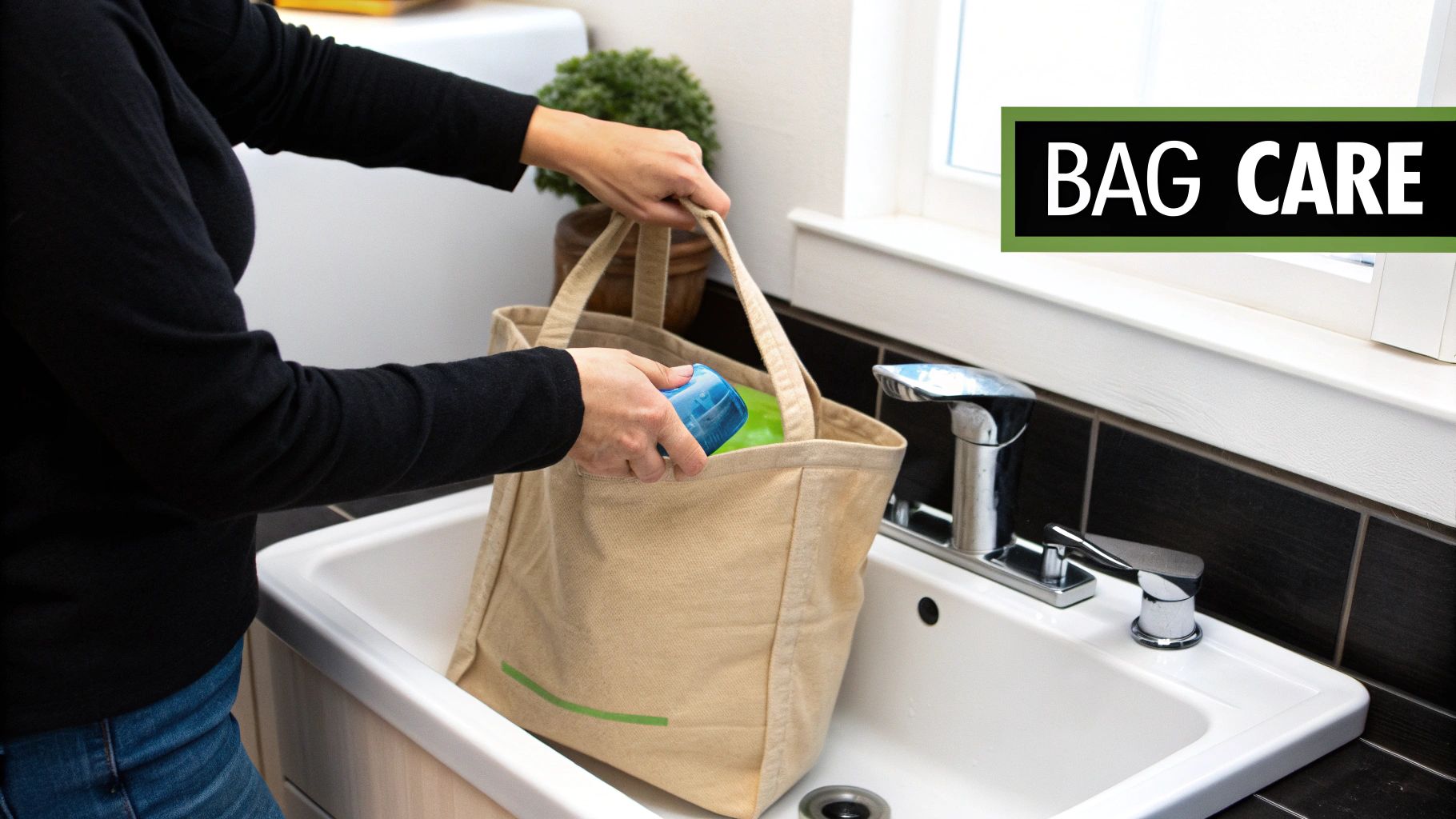
Why Are Sustainable Bags Often More Expensive
It’s usually the first thing people notice: bags from conscious brands can cost a bit more. But this isn't about marking things up for no reason; it’s about reflecting the true cost of making something the right way. That price difference comes from a deep-seated commitment to quality and ethics—things fast fashion often overlooks.
These brands are simply making better choices from start to finish.
- Fair Wages for Workers: Ethical brands make sure the artisans and factory workers behind their products earn a living wage in safe, healthy conditions. That’s a non-negotiable cost that supports everyone involved.
- High-Quality Eco-Materials: Finding GOTS-certified organic cotton, innovative plant-based leathers, or recycled fabrics costs more than churning out cheap, new synthetics. This investment in better materials really pays off in durability and a much smaller environmental footprint.
- Cost of Certification: Earning those trusty certifications we talked about involves rigorous audits and fees. It's the price of transparency—a brand paying to have its claims double-checked so you can shop with confidence.
When you buy a sustainable bag, you’re not just buying an object. You're investing in a healthier planet, supporting fair labor, and casting a vote for a more responsible fashion industry. The price reflects true value, not just a random cost.
How to Care for Your Eco-Friendly Bag to Make It Last
Making things last is the soul of sustainability. The most eco-friendly bag is the one you love and use for years, and a little TLC is all it takes to make that happen. When you extend the life of your bag, you dramatically reduce waste and consumption, which makes your initial investment even more powerful.
While every material has its quirks, a few general rules apply. Always check the brand's care label first—they know their products best. But for most common fabrics, these tips will keep your bag looking great for the long haul.
General Care Guidelines:
- Fabric Bags (Canvas, Organic Cotton, Hemp): Spot cleaning is your best friend. Just use a mild soap and a soft cloth to tackle stains right away. For a deeper clean, hand wash it in cold water and let it air dry.
- Vegan Leathers (Cork, Piñatex, High-Quality PU): A simple wipe-down with a damp, soft cloth is all you need. Steer clear of harsh chemical cleaners or scrubby sponges that could damage the finish.
- Proper Storage: When you're not using your bag, keep it in a cool, dry place out of direct sunlight. Stuffing it with a bit of paper can help it hold its shape.
Is a Vegan Bag Always a Sustainable Bag
This is a fantastic and super important question. The short answer is no, not always. The words "vegan" and "sustainable" often hang out together, but they’re talking about two different things. A vegan product just means no animal-derived materials were used—a crucial ethical line for many people.
Sustainability, on the other hand, is about the entire environmental impact. Some older or cheaper "vegan leathers" are made from PVC (polyvinyl chloride), a plastic that’s notoriously nasty to produce and dispose of.
For a bag to be both vegan and genuinely sustainable, you want to see better materials. Look for innovative, plant-based options like cork, pineapple leaf fiber (Piñatex), or mushroom leather, or high-quality recycled materials. The best brands are upfront about what their vegan materials are made of, so you can make a choice that’s kind to both animals and the planet.
At The Simple Discipline, we believe self-expression and sustainability should go hand in hand. Our collection of eco-conscious and vegan bags is all about bringing artful, bold style into your life without asking you to compromise on your values. Explore our unique designs and find a piece that speaks to you at The Simple Discipline.
Article created using Outrank